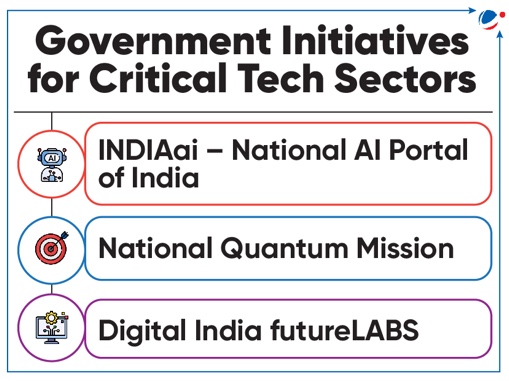Why in the news?
The Ministry of Electronics and Information Technology (MeitY) recently unveiled draft road maps for Critical Tech Sectors.
More on the news
- Draft Roadmaps were prepared by Centre for Development of Advanced Computing (C-DAC), giving emphasis on indigenisation of software and hardware in the critical sectors.
- They aim to solve a series of issues by different time spans between now and 2047, the centenary of Indian independence, with specific domestic research goals outlined.
- They aim to synergize efforts of stakeholders to align with NITI Aayog's strategy for Research and Development.

What are Critical Technology Sectors?
- Critical Technologies are those technologies identified by government as ‘Critical’ for a nation's
- future economic growth,
- national security, and
- technological advancement.
- These often involve:
- cutting-edge research,
- innovation, and
- strategic importance.
- These sectors typically receive heightened oversight from the government and improving technology investment environment.
- They are important for state’s critical infrastructure.
- As they offer safe, cost-effective and reliable service and can act as a predictive tool for forecasting potential failures.
- Examples of Critical Technology Sectors include Artificial Intelligence (AI), Quantum computing, Internet of Things, and Blockchain.
Significance of Critical Tech Sectors
- Global Partnership: They promote India’s technological leadership; cooperation with partners to advance and maintain shared technological advantages, making India trustworthy international technology partner.
- Indigenisation: Critical technologies help deter foreign hostile forces from economic espionage, strengthen the protection of key technologies.
- It avoids the damage to national and industrial interests caused by illegal technology outflows.
- Economic growth: Drives innovation and competitiveness across key industries and creates job opportunities and boosts GDP growth.
- Strengthening Mobile security and Privacy: Enterprise-grade security systems are particularly crucial for businesses to safeguard their intellectual property, customer data, and operational continuity.
- Cryptography: Robust cryptographic techniques are essential for protecting sensitive data, securing online transactions, and maintaining trust in digital interactions.
- IoT Security: It is crucial to mitigate the risks like disrupting critical services and ensure the resilience of IoT ecosystems.
Critical technology collaborations with other countries:
 |
Challenges in developing critical tech sectors
- Education and Skills Gap: Despite producing a large number of STEM graduates, there's often a gap between the skills taught and those required by industries.
- Brain drain: India faces brain drain in AI algorithms and hardware accelerators as many opt post graduate training in USA and Europe.
- Research and Development Funding: While India has made strides in R&D, there's still a need for increased funding and investment in R&D to foster innovation and technological breakthroughs.
- Global Competition: India faces stiff competition from other countries like China, USA, etc., particularly in emerging technology sectors such as AI and quantum computing.
- Environmental Concerns: Technology sectors growth requires addressing energy consumption, electronic waste management, and sustainable manufacturing practices.
Way Forward: Key Highlights of the Roadmaps
| Critical tech sector | Roadmaps | Target |
Quantum Technologies
| Focus on developing superconducting materials | From 2023-2028 |
Public key infrastructure | From 2023-2034 | |
Cryptography
| Create centre of excellences for cryptography | By 2034 |
Focus on quantum-resistant cryptography, novel non-linearity schemes, etc. | From 2024-2034 | |
Mobile Security
| Indigenous ecosystem for Secure OS and Mobile hardware | By 2030 |
Deploy "self-defending security" and "quantum-backed security" for mobile systems | By 2047 | |
| Internet of Things (IoT) security | Develop an IoT sandbox, IoT network security orchestration, and automation | From 2024-2047 |
Work on Zero trust architecture, New chip design and standards. | From 2029-2047 | |
Cyber Forensics
| Develop ‘Social Media Analytics’ | By 2026 |
Create ‘Dark Web Forensics’ and forensics tools for sectors like deep-fakes, UPI apps, and tools for reconstructing events from CCTV footage. | By 2030 |



